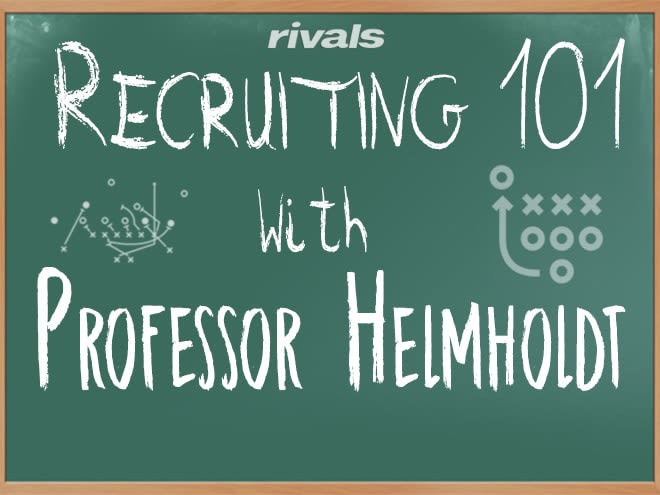Recruiting 101: The rankings, part 2

Recruiting is known as the “lifeblood” of a college football program, but the complexity of the process can be confusing for prospects and college football fans alike. In our Recruiting 101 series we will look to clarify some basic topics and explain more advanced topics about college football recruiting, while also answering those questions you have been afraid to ask. This week’s topic is about the rankings.
Rankings are the measuring tool of the recruiting process. It is an answer to the question, who will this player be at the next level? Here we discuss Rivals.com’s rankings which, in its current form, have been around since 2001 with only a few minor tweaks in those 18 years. This is Part 2 of the lesson on recruiting rankings.
MORE RECRUITING 101: The calendar | The offer | The commitment | The rankings, part 1
THE EVALUATION PROCESS
The eight-member Rivals analyst team is the final arbiter of prospect ratings, but we solicit input from a range of knowledgeable recruiting insiders, including colleagues throughout the Rivals.com network and college coaches.
Determining an individual prospect’s rating includes evaluating in-season film and seeing prospects in-person, including at their games, camps and 7-on-7s. The more information we have on a prospect, the stronger the evaluation, and every opportunity to evaluate a prospect is valuable.
Seeing a prospect in-game gives you that full football representation, but often the competition is less than Division I-caliber and the game plan may limit how often a prospect is featured. Attending a game where a wide receiver only gets the ball thrown his way three times is not going to provide much useful data to help determine that prospect’s ability.
Camps, like the Rivals 3 Stripe Camp presented by adidas, gives you that Division I vs. Division I competition and provides more repetitions from which to evaluate prospects than games, but can only simulate actual football in most cases. Meanwhile, 7-on-7 combines some elements of both camps and games, but also has limitations in simulating football and only features skill position players.
The best evaluation opportunity in a prospect’s high school career is usually the top all-star games, like the All-American Bowl in San Antonio and the Under Armour All-America Game in Orlando. That is full football that features Division I vs. Division I competition, but only about 200 prospects in a class get the opportunity to play in those games.
In-season games, camps, 7-on-7s and all-star games all provide useful data and all are included in a prospect’s evaluation. In the end, every evaluation opportunity is considered to help determine who that prospect will be at the next level, which is then represented by his rating.
RANKINGS UPDATES
Ten years ago, the first rankings for a class did not come out until the summer before senior year. That timetable has been accelerated due to scholarship offers, and commitments, being made earlier. Today, the first rankings of a class arrive in the summer before junior year. Rankings are then updated approximately every three months, determined by the different evaluation cycles throughout the year.
Not all prospects who will eventually be evaluated as Division I caliber are rated in that initial rankings release for a class. A prospect who is rated for the first time can receive his stars and Rivals Rating in the middle of an evaluation cycle, but he will not be ranked until the full updates are done at the end of the cycle.
The first update to the initial rankings are made in December after junior seasons are complete. There is then an update in February of junior year, another in June following spring camps and combines and another in August following the summer camps and summer 7-on-7. The last two updates to the Rivals rankings come in early December after senior seasons are complete, and then a final one in January of senior year after the winter all-star games. That January update is then locked in and preserved for posterity.
A QUESTION AND AN ANSWER
On the most recent episode of the Rivals Ranking Podcast, I discussed this topic as it pertained to the NFL Draft Combine and football evaluations in general. The most overrated drill is the 40-yard dash, hands down. How many times in football do you run in a straight line for more than a few yards at a time? Yet, coaches, scouts and fans hear 'he ran a 4.4 40-yard dash' and they get all dreamy-eyed.
A much better way to measure football speed is the pro-agility (5-10-5) shuttle or the three-cone drill, also known as the “L-drill.” Those factor in the ability to stop, start, change direction and how quickly you can accelerate to top speed – in other words, actions you will actually be doing on a football field.
For the most underrated drill, I’ll go with the vertical jump. The layman thinks the vertical just measures how high a person can jump, but the vertical is really a measurement of explosion. Whether you are coming off the snap, delivering a hit to a ball carrier or making a cut, your explosive ability is crucial. My first strength and conditioning coach told me that clean was the best football lift because it builds explosiveness. The vertical jump, then, measures that explosion.
